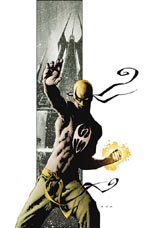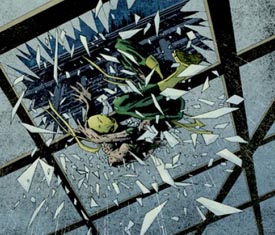 Written by Ed Brubaker and Matt Fraction
Written by Ed Brubaker and Matt Fraction
Art by David Aja
Additional art by Travel Foreman, Derek Fridolfs, and John Severin
32 pages, color
Published by Marvel Comics
The longer you’ve been familiar with the world of super-hero comics, the more you know some things to be true. Sooner or later, all characters will come back from the dead. Sooner or later, all characters who once starred in their own book that was since cancelled will get another headlining book. And sooner or later, you’ll get a real apathy towards the endless recycling and rehashing of the same characters over and over again. It’s because of this last one that I almost missed out on one of the latest revamps at Marvel, The Immortal Iron Fist. And now I feel stupid for doing so, because the reality is that it’s actually quite good.
Danny Rand is the CEO of Rand Corporation, a multi-million dollar business. He’s also Iron Fist, the martial-arts using hero using his titular power to smash through all of his foes. Now he’s finding himself besieged on all sides—through his business, through his costumed identity, and worst of all, through his own legacy.
Having never read an Iron Fist comic before, I was impressed at how easily Ed Brubaker and Matt Fraction laid out the basic idea of the character for new readers. It helps, of course, that the basic concept of Iron Fist is pretty simple. Brubaker and Fraction are quickly building on that, though, creating a series of legacy Iron Fists from throughout the ages even as it ties into the present day. It’s a clever idea, one that simultaneously grounds Danny Rand as part of something larger even as it makes him actually feel more unique by his differences between the past Iron Fists and himself. Rand himself is also dealt with well by Brubaker and Fraction, making his civilian identity one with its own problems and plot hooks to pull the reader in. Rand’s an affable, pleasant character to read about, and his relationships with both his friends and his business associates make you want to read more about him. For a character that seemed to have been revived based on reader’s past impressions and fond memories, he’s proven to be a draw in his own right thanks to the handling here.
 David Aja’s art is a good choice for the comic, grounded firmly in the real world but without looking photo-referenced or stiff. A book starring a martial artist needs to have a loose, fast-flowing art style and that’s exactly what you get here. When Iron Fist falls through a window at the start of the second issue, the shards of glass exploding outwards are patterned in such a way that you actually feel like they’re moving amidst Iron Fist’s body in its defensive crumpled position, plummeting towards the ground. Matt Hollingsworth’s colors help a great deal as well, using a limited color palette for each scene. Night time truly feels like it’s three in the morning thanks to the dark blues and indigos, even as scenes at Rand Corporation are brightly lit like any good business with bright yellows and tans. Last but not least, the flashback sequences by Travel Foreman and John Severin look great; Foreman’s China of five hundred years ago is drawn cleanly and uncluttered, and Severin’s World War I trench warfare with its grainy, detailed figures are nothing short of gorgeous. It’s a nice visual difference to instantly know that the book’s in a different time period, but at the same time it never comes across as gimmicky.
David Aja’s art is a good choice for the comic, grounded firmly in the real world but without looking photo-referenced or stiff. A book starring a martial artist needs to have a loose, fast-flowing art style and that’s exactly what you get here. When Iron Fist falls through a window at the start of the second issue, the shards of glass exploding outwards are patterned in such a way that you actually feel like they’re moving amidst Iron Fist’s body in its defensive crumpled position, plummeting towards the ground. Matt Hollingsworth’s colors help a great deal as well, using a limited color palette for each scene. Night time truly feels like it’s three in the morning thanks to the dark blues and indigos, even as scenes at Rand Corporation are brightly lit like any good business with bright yellows and tans. Last but not least, the flashback sequences by Travel Foreman and John Severin look great; Foreman’s China of five hundred years ago is drawn cleanly and uncluttered, and Severin’s World War I trench warfare with its grainy, detailed figures are nothing short of gorgeous. It’s a nice visual difference to instantly know that the book’s in a different time period, but at the same time it never comes across as gimmicky.
If I had to sum up the appeal of The Immortal Iron Fist in one word, it would probably be fun. The series moves at a good clip, with just the right mix of action and intrigue to keep you wanting more. By the time I finished the second issue, my immediate thought was, “When does issue three hit the stands?” Brubaker, Fraction, and Aja should be proud.
